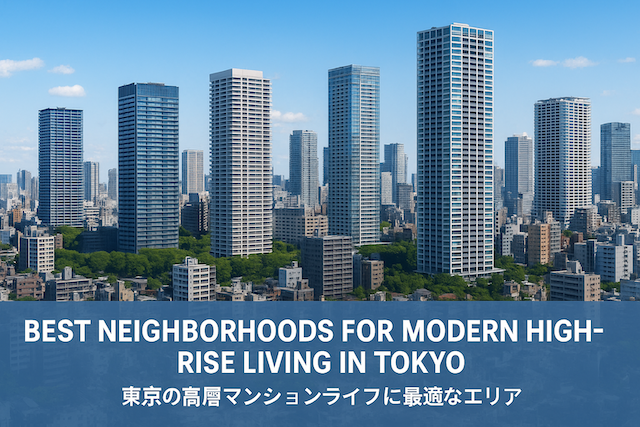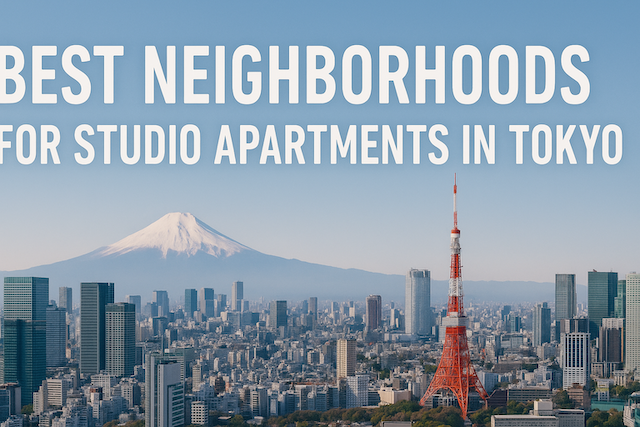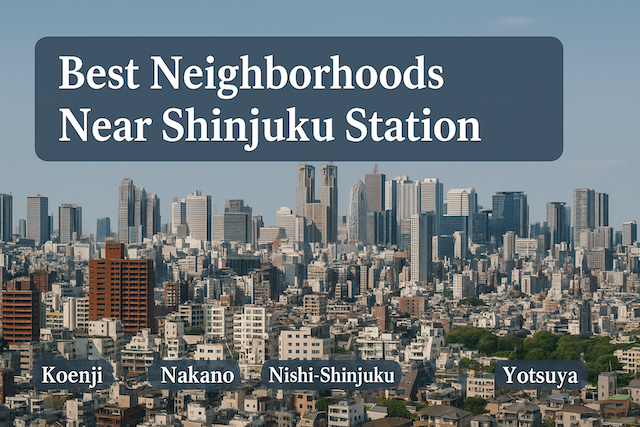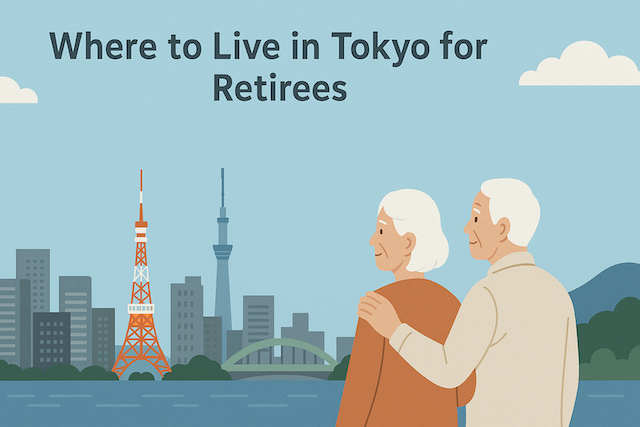Best Neighborhoods for Modern High-Rise Living in Tokyo
Tokyo’s skyline is a dazzling blend of futuristic architecture and urban sophistication. For those who appreciate luxury, convenience, and panoramic city views, modern high-rise living offers the ultimate lifestyle. From waterfront developments in Kachidoki to the urban chic of Roppongi Hills, Tokyo has a variety of neighborhoods that cater to those seeking the best in high-rise living.
Below, we explore Tokyo’s most desirable areas for modern tower apartments, covering their lifestyle appeal, amenities, accessibility, and overall living environment.
Roppongi Hills and Azabudai Hills: Tokyo’s Premier High-Rise Lifestyle
Roppongi and its neighboring area, Azabudai, define luxury vertical living in Tokyo. These twin districts are home to iconic complexes such as Roppongi Hills Mori Tower and the recently opened Azabudai Hills, which reimagines the city’s skyline.
Why Live Here
Roppongi Hills is a complete lifestyle ecosystem — luxury residences, Michelin-star restaurants, designer boutiques, art galleries, and green spaces like Mori Garden. The new Azabudai Hills complex extends this concept, combining high-end apartments, offices, and cultural spaces within a nature-integrated urban design.
Highlights
-
24-hour security, concierge services, and private gyms.
-
Walking distance to Tokyo Midtown and Roppongi Station.
-
Home to international residents, diplomats, and business executives.
Who It’s For
Those seeking a prestigious address with modern convenience, international culture, and top-tier amenities.
Shibuya: Futuristic Urban Energy and Vertical Innovation
Shibuya has transformed into a hub of modern skyscrapers, headlined by Shibuya Scramble Square, Shibuya Stream, and Shibuya Sakura Stage. These developments symbolize Tokyo’s next-generation urban design — sleek, efficient, and ultra-connected.
Why Live Here
Living in Shibuya means being at the heart of Tokyo’s creative pulse. High-rise apartments offer breathtaking city views and instant access to everything — tech hubs, shopping centers, co-working spaces, and gourmet dining.
Highlights
-
Direct connection to Shibuya Station, the city’s busiest transport hub.
-
Cutting-edge smart-home technologies in new tower apartments.
-
Close to Daikanyama and Ebisu for a more relaxed weekend lifestyle.
Who It’s For
Young professionals, entrepreneurs, and digital creatives who value a vibrant, connected, and futuristic environment.
Shinagawa: Modern Waterfront Towers and Business Luxury
Shinagawa has evolved into a key business and residential hub, offering some of Tokyo’s most modern high-rise living options near the Shinagawa Intercity and Takanawa Gateway areas.
Why Live Here
Its proximity to Tokyo Station and Haneda Airport makes Shinagawa ideal for global professionals. High-rise residences such as The Parkhouse Shinagawa Tower and City Tower Takanawa combine convenience with refined design.
Highlights
-
High-speed access to Kansai and beyond via the Shinkansen.
-
Scenic waterfront promenades and modern office complexes.
-
Excellent bilingual healthcare and international schools nearby.
Who It’s For
Executives and frequent travelers seeking modern comfort with easy transport connections.
Kachidoki and Tsukishima: Tokyo Bay’s New Vertical Communities
Located along the Tokyo Bay area, Kachidoki and Tsukishima have undergone massive redevelopment, featuring luxurious high-rises with river and skyline views. The Tokyo Towers and Harumi Flag (built for the Tokyo Olympics) represent the future of sustainable, modern high-rise communities.
Why Live Here
These neighborhoods offer spacious, family-friendly apartments with modern layouts — a rare find in central Tokyo. Many buildings include amenities like rooftop terraces, gyms, and daycare centers.
Highlights
-
Beautiful waterfront views and cycling paths.
-
Short access to Ginza and Tokyo Station.
-
Increasingly popular with both Japanese and expat families.
Who It’s For
Families and professionals seeking modern waterfront serenity with urban convenience.
Shinjuku: Central, Connected, and Tower-Oriented
Shinjuku remains one of Tokyo’s most dynamic districts, known for its skyscraper district on the west side. Modern residences like The Parkhouse Nishi-Shinjuku Tower 60 and Tokyo Opera City Tower offer top-notch facilities amid the city’s commercial and entertainment energy.
Why Live Here
Shinjuku combines access, shopping, and nightlife with high-end residential options that prioritize privacy and comfort. Despite being a bustling district, newer towers are designed with advanced soundproofing and sky-view lounges.
Highlights
-
Excellent access to multiple train and subway lines.
-
High-rise dining and panoramic lounges.
-
Major business, entertainment, and shopping centers nearby.
Who It’s For
Urban professionals and city lovers who want to live in the heart of Tokyo’s action.
Toyosu and Ariake: Tokyo’s Smart Waterfront Developments
Toyosu and Ariake, both part of the Tokyo Bay area, are redefining high-rise living with smart-city features and large-scale residential complexes. Developments like Park Tower Toyosu and Brillia Ariake City Tower combine eco-friendly designs with high technology.
Why Live Here
These neighborhoods provide open-air spaces, parks, and family-friendly infrastructure while maintaining easy access to central Tokyo. The area’s transformation into a modern urban oasis attracts both young families and professionals.
Highlights
-
Clean air, wide sidewalks, and new shopping complexes.
-
Excellent childcare, schools, and healthcare facilities.
-
Direct train lines to Ginza, Odaiba, and Tokyo Station.
Who It’s For
Those who prefer modern, sustainable urban living in a peaceful waterfront setting.
Meguro and Ebisu: Stylish High-Rise Living with a Neighborhood Feel
While Meguro and Ebisu are not as high-density as Shinjuku or Roppongi, they have seen a rise in boutique high-rise residences that balance design with comfort. Ebisu Garden Place Tower and Meguro Sky Garden Residence are notable examples.
Why Live Here
These neighborhoods offer a sophisticated lifestyle with easy access to central Tokyo. Ebisu’s culinary scene and Meguro’s green spaces make them ideal for those who want an elegant, balanced life.
Highlights
-
Great dining, shopping, and cultural activities.
-
Modern architecture blending with traditional charm.
-
Quiet yet well-connected to Shibuya and Roppongi.
Who It’s For
Professionals and expats seeking elegance with a community vibe.
Ikebukuro: Emerging High-Rise Hotspot in North Tokyo
Ikebukuro has transformed significantly in recent years with projects like Hareza Tower and Global Ring, turning the area into a lively mix of culture and modern living. Tower mansions are becoming a trend here, offering value and convenience.
Why Live Here
Ikebukuro provides more affordable high-rise options compared to central Tokyo while offering direct access to major lines. It’s becoming an attractive option for younger professionals and small families.
Highlights
-
Major redevelopment of East and West Ikebukuro areas.
-
Excellent access to the Yamanote Line and Shinkansen routes.
-
A balance between affordability and urban comfort.
Who It’s For
Budget-conscious residents seeking modern high-rise comfort with strong city connectivity.
Akasaka and Toranomon: Exclusive High-Rise Elegance
Akasaka and Toranomon combine diplomatic prestige with luxurious urban living. Projects such as Toranomon Hills Residence and Akasaka The Residence are among the most sought-after properties in Tokyo.
Why Live Here
These districts are known for their privacy, refined aesthetics, and access to Tokyo’s major business centers. Residents enjoy panoramic city views, hotel-like services, and proximity to embassies and top-tier dining.
Highlights
-
World-class facilities, including spas and lounges.
-
Close to government buildings, embassies, and global offices.
-
Home to several 5-star hotels and international schools.
Who It’s For
High-net-worth individuals and executives valuing security, prestige, and exclusivity.
Minato Ward Overall: The Core of Tokyo’s High-Rise Culture
While each district has its own identity, Minato Ward (covering Roppongi, Akasaka, and Azabudai) is the epicenter of high-rise luxury living. The area continues to evolve with state-of-the-art developments and remains Tokyo’s most prestigious residential address.
Highlights
-
Proximity to business, entertainment, and international schools.
-
Exceptional skyline views and urban greenery.
-
Popular among expats and corporate tenants.
Tips for Choosing a High-Rise Apartment in Tokyo
Before committing to a tower residence, consider the following:
-
Seismic Safety – Choose buildings constructed under Japan’s newest earthquake-resistant standards.
-
Amenities – Look for facilities like gyms, sky lounges, security, and bilingual concierge.
-
Commute – Ensure proximity to major stations for easy citywide access.
-
View and Orientation – South-facing units often provide more sunlight and better resale value.
-
Monthly Fees – Tower mansions often have higher maintenance and management fees.
Final Thoughts
Tokyo’s modern high-rise neighborhoods offer more than just luxury — they represent the city’s vision of future living: safe, efficient, and integrated. Whether you want the prestige of Roppongi Hills, the tech-forward vibe of Shibuya, or the calm waterfront of Toyosu, there’s a perfect tower for every lifestyle.
From panoramic skyline views to world-class amenities, high-rise living in Tokyo is not just about height — it’s about living above the ordinary.
What does “modern high-rise living” mean in Tokyo?
In Tokyo, modern high-rise living usually refers to newer “tower mansions” (high-rise condominiums or rentals) with advanced seismic engineering, 24/7 security, concierge desks, on-site gyms, sky lounges, shared workspaces, package lockers, and smart-home features. These buildings cluster in redevelopment areas such as Roppongi/Azabudai, Shibuya, Shinagawa, Toyosu/Ariake, Kachidoki, and parts of Shinjuku and Minato Ward.
Which neighborhoods are considered the most prestigious for high-rise apartments?
Roppongi Hills, Azabudai Hills, Toranomon, and Akasaka lead the prestige list thanks to luxury towers, hotel-grade services, proximity to embassies, Michelin dining, and art/culture hubs. These areas offer panoramic views and refined amenities that appeal to executives, diplomats, and high-net-worth residents seeking an address with global cachet and excellent urban convenience.
Where can I find a balance of modern towers and a family-friendly vibe?
Kachidoki, Tsukishima, Toyosu, and Ariake excel for families. They feature spacious units, newer schools and daycare options, broad sidewalks, parks, waterfront promenades, and large shopping complexes. Many towers include kids’ rooms, party lounges, and on-site clinics, creating a safe and practical environment without sacrificing access to central Tokyo.
Is Shibuya good for high-rise living or is it too busy?
Shibuya has transformed into a next-generation high-rise hub with projects like Scramble Square and Shibuya Stream. While the station area is lively, upper-floor residences provide quiet, views, and direct access to world-class transit, dining, co-working, and culture. It’s ideal for creatives, founders, and professionals who want energy outside and calm above it.
How does Shinagawa compare for frequent travelers?
Shinagawa is superb for mobility: Shinkansen access, Haneda Airport proximity, and major office clusters. Modern towers around Takanawa and Konan offer sleek designs and business-focused services. Residents choose Shinagawa for time savings—door-to-door travel is efficient, and weekday routines are streamlined by integrated retail and dining in and around the station.
Are there more affordable high-rise options?
Relative value can be found in Ikebukuro and parts of northern/western Tokyo where redevelopment is accelerating. While still modern and well-equipped, these towers may price below Minato or Shibuya equivalents. You’ll trade a bit of brand prestige for larger layouts per yen, strong rail connectivity, and expanding cultural and dining scenes.
What should I know about earthquake safety in tower mansions?
Look for buildings constructed under the latest seismic codes, often featuring base isolation or vibration control systems. Property brochures and management offices can confirm engineering specs. Higher floors may sway more during tremors, but systems are designed to absorb energy. Emergency power, water reserves, and community drills are also common features.
Do towers allow pets, and are there pet-friendly neighborhoods?
Pet policies vary by building. Many new towers allow small dogs or cats with registration and house rules (e.g., elevator etiquette, carrier use). Areas with ample parks or waterfront walks—Toyosu, Ariake, Kachidoki, and Meguro’s river pathways—are popular. Always verify pet deposits, cleaning fees, and breed/size limits before applying.
How noisy are high-rise apartments in central districts?
Modern towers use high-performance glazing and insulation, so interior noise is generally minimal even near busy roads or stations. Upper floors reduce street-level sounds further. That said, proximity to nightlife zones (e.g., parts of Roppongi or Shinjuku) may bring weekend ambient noise. Ask about window specs and orientation during viewings.
What monthly costs should I expect besides rent or mortgage?
Expect higher management fees and repair fund contributions in towers due to extensive shared facilities. Utilities can be efficient in new builds, but sky lounges, gyms, and concierge services add overhead. Parking is often extra. Renters may face key money, agency fees, and renewal fees; owners should budget for periodic large-scale maintenance.
Which neighborhoods offer the best commute options?
Shinjuku, Shibuya, Shinagawa, and Minato’s hubs (Roppongi, Toranomon) are unbeatable for transit. Multiple subway/JR lines intersect, enabling short, predictable commutes. Waterfront areas like Toyosu and Kachidoki offer direct lines to Ginza and Tokyo Station; plan around your daily routes and confirm walking times from tower lobbies to stations.
Are views and orientation really worth the premium?
Yes—views and sunlight influence comfort and resale potential. South-facing units often capture better daylight. Corner units and higher floors maximize skyline, bay, or mountain vistas and reduce sightline obstructions. However, they command higher prices. Decide whether daily light and view quality align with your priorities and long-term hold plans.
How do amenities differ among neighborhoods?
Minato’s luxury cores emphasize hotel-like services, art, and fine dining. Shibuya favors tech-forward amenities and co-working. Shinagawa optimizes business travel convenience. Waterfront districts focus on parks, family rooms, and large supermarkets. Shinjuku balances business and leisure with panoramic lounges. Match amenity style to your lifestyle rather than chasing generic checklists.
What is the typical leasing or purchase process for towers?
For rentals, expect income verification, guarantor/company screening, and initial fees (deposit, key money, agency). For purchases, pre-approval (loan “kakunin”), property disclosure review, management rules, and reserve fund health are critical. Work with bilingual agents experienced in tower transactions, and review by-laws for renovation, pets, and short-term use restrictions.
Is Minato Ward always the best choice for expats?
Minato is the epicenter of luxury towers and international services, but “best” depends on your routine. If you prioritize schools and embassies, Minato shines. If you want family-friendly parks and larger layouts, Toyosu/Ariake or Kachidoki may fit better. For cost-performance and culture, Ikebukuro or Meguro/Ebisu can be excellent.
Any red flags to watch for when comparing tower buildings?
Scrutinize management quality, reserve fund status, and history of special assessments. Confirm seismic specs, evacuation routes, and backup systems. Check elevator count versus unit numbers to avoid peak-hour bottlenecks. Review rules on renovations, EV charging, and package handling. Visit at night and weekday rush to gauge real-life convenience.
How can I shortlist neighborhoods quickly?
Start with your daily anchors: office location, preferred international school, and airport access needs. Choose two or three nodes (e.g., Roppongi/Azabudai, Shinagawa, Toyosu/Kachidoki), then tour one luxury tower and one value-oriented tower in each. Compare commute reliability, daylight, noise, lobby-to-train time, and overall management professionalism before deciding.
https://tokyorelocationguide.com/neighborhoods/



![Where to Live in Tokyo for Expats [2025-2026 Guide]](https://tokyorelocationguide.com/wp-content/uploads/2025/10/ChatGPT-Image-Oct-17-2025-03_50_34-PM.png)
![Where to Live in Tokyo for Families with Kids [2025–2026 Guide]](https://tokyorelocationguide.com/wp-content/uploads/2025/10/ChatGPT-Image-Oct-17-2025-03_55_59-PM.png)


